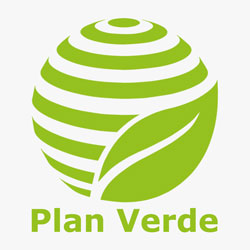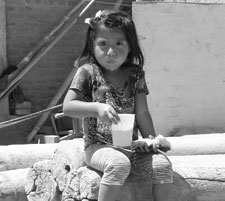From 1994 – 2006, we did consulting both in the environmental field and in the biological and naturopathic products trade. We did this through our own business: “PUR – Die BioDrogerie” (PURE – the Organic Apothecary) in our hometown of Hanover, Germany. We had two main reasons for temporarily going to Peru: firstly, to continue our professional activities exporting raw materials and products for the organic trade within Germany, and secondly, to locally promote active environmental protection using technology to restore different soils and waters.
Through our travels in the raw materials-producing countries and conversations with customers and suppliers, it soon become very clear that most people are barely concerned with the origin of the products. In this regard, more transparency and clarification are needed.
This applies particularly to the living conditions of local people. Many people are aware that poverty exists in these areas. So were we, when we went to Peru. However, we didn’t realize the extent of that poverty, nor its complexities, until we were actually there.
Piura is the first, and until now one of the largest, agricultural regions of South America. After almost 400 years of colonial history, most people there continue to work as farm workers and laborers. The large export companies pay seasonal harvest workers an average of 12.00 soles (US$3.77) per day. This is not enough to feed any family here. The extent of the poverty is unimaginable for many of us. Just as inconceivable is the fact that these people can exist at all in their huts on the sand – with neither water nor electricity.
In early 2007, my father, Gunter Hartung, visited us. He joined us in closely exploring large parts of the region. As a journalist with extensive global knowledge, he, too, was considering what support measures could be useful for areas of this size and type. One thing was clear to all of us. The situation in the regions of Piura, Tumbes and Lambayeque, with their deserts and thorn-covered savannas, is comparable to the dry and over-farmed areas in Africa.
A short time later, in June 2007, we discovered a neem tree in the city of Piura. We knew this species well since neem products were an integral part of our product range in our business in Hanover. It was precisely this tree which, with its many uses, is the solution to many global problems.
For the past 25 years, farming projects in Africa have planted over 60 million neem trees in areas in the Sahara, thus creating livable conditions for the rural population.
We were thrilled. Neem trees obviously grow and thrive here! However, a question quickly arose: what was the origin of the tree, and who had planted it here? According to our investigation, we counted a total of 50 neem trees in the city of Piura, all of which came from two sources. First, a civil engineer, who 10 years earlier had received a couple of seeds from an Indian agricultural engineer, had planted the first neem trees in Piura. We had a number of conversations with the family of this man, who had unfortunately died five months earlier. Although he had been unaware of the vast scale of the neem tree’s benefits, he had pursued the idea of using this unassuming tree as greenery in his construction projects. Second, more neem trees were cultivated by a lady who had received a few seeds from a Hindu man eight years previously and who wanted to contribute to the greening of the urban area.
Due to both the lack of opportunities for intensive propagation and ignorance about this tree and its benefits, no further trees other than these were cultivated. Even in academic circles, where information containing really useful knowledge and its implementation flow freely, educated people are strangely resistant.
Since the early 1990s, increasing numbers of publications on the neem tree have appeared. These publications are of great scope and thoroughly researched.
A big thanks goes especially to Prof. Dr. Schmutterer (Institute of Phytopathology and Applied Zoology at the Justus-Liebig University, Giessen, Germany: “The Father of the Modern Neem”), whose powerful, almost 1,000 page work The Neem Tree, contains compelling research results collected from many parts of the world. If one examines the calls to action expressed by large, well-known organizations, it becomes evident that, following the abolition of slavery, the fight against poverty in the producing countries is a complex issue.
The need for relief items such as food, clothing, medicines and education, which are provided here and there, is like a bottomless pit. Just a short time ago, the German government launched a 30,000-hectare (74,131 acres) methanol project together with € 260 million (US$28.6 million) in aid. The bio-fuel market is booming, and it is laudable that this market also intends to create more jobs in the agricultural industry. However, the farm workers experience barely any benefits at all in terms of their life situations being improved. Based on our current experience, it is at this point that we fail to have any insight into the cause and definition of poverty, nor any strategic and principle-based measures for providing help which leads to self-help.
Ultimately the first question we need to consider is, what are the conditions required for life to exist? Just one glance at history should be enough to answer this question. The presence of opportunities in the form of raw materials for crafts and commerce have formed the basis of all cultures whose structures have been preserved, some of them even to this day, as testimonials. We believe that opportunities arise from the raw materials provided by trees. They are the basis for the expansion of a culture, and they are what has been taken away from these areas by large-scale land-clearing, not having been replaced even today. As a solution, the neem tree provides the optimal and quickest results. Moreover, we have learned here and understood that there is not much time left over the long term to implement these plans.
Today, people in these areas know exactly the destination and quality of their products in the flow of goods. Whoever gets off the beaten track and visits this place as a tourist is amazed that there is no good coffee, chocolate is more expensive than in Germany, and other food and goods being sold in the region turn out to be, based on our way of thinking, of a very low quality. In addition, these goods are just as expensive as in a German supermarket. We in Western countries should begin now to substantially improve the situation in Third World countries. Otherwise, in the near future we will increasingly face migrants escaping rural areas to settle in our cities. Basically, these people would much rather live in their own environment, but often, for economic reasons. they have no other choice, and seek their fortune in the cities. We need to understand the system on which we all depend for our existence. We should distance ourselves from it in order to act without any misunderstood sense of charity.
This is because it is we who are ultimately exports consumers. For whatever kind of development aid we may decide on, what should stand as our prime objective are renewable raw materials and the creation of enduring value for future generations. In addition, we are eager for the “Plan Verde” project to become the subject of international dialogue and that it may be implemented in many other comparable areas.




